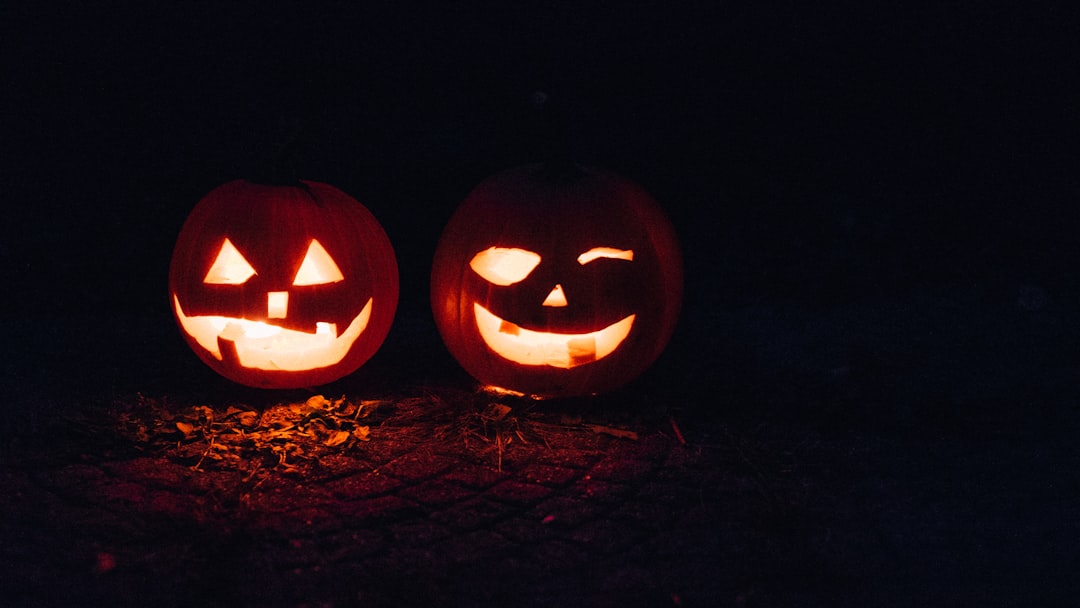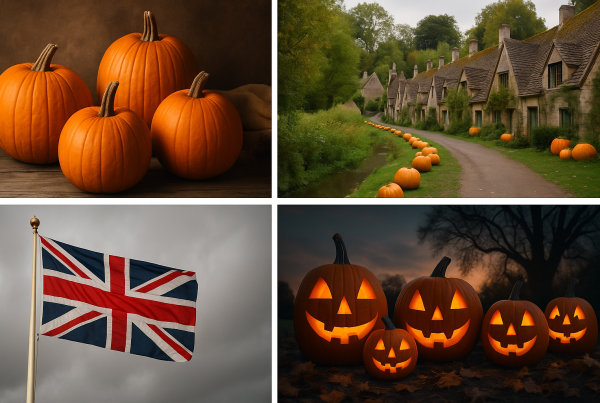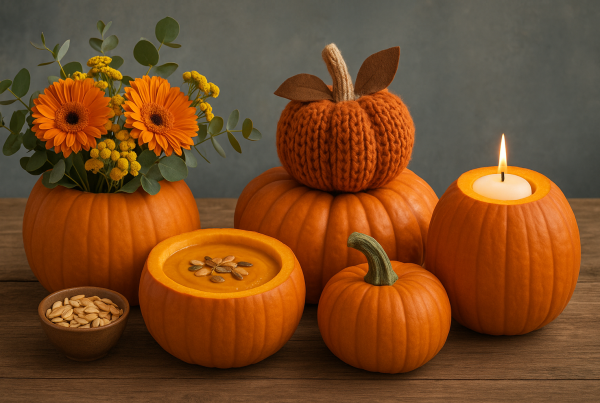The Evolution of the Halloween Pumpkin: From Ancient Turnips to Modern Jack-o’-Lanterns
The Halloween pumpkin, now synonymous with the haunting festivities of October, has a rich and intriguing history that spans continents and centuries. Originally, the practice of carving jack-o’-lanterns began with the ancient Celts, who used turnips during their Samhain celebrations to ward off spirits. It wasn’t until Irish immigrants brought their traditions to America that the pumpkin, easier to carve and more abundant, became the centerpiece of Halloween decor. This blog post will unravel the history of jack-o’-lanterns, explore the cultural significance of Halloween, and celebrate the diverse international Halloween celebrations that have emerged over time. Join us as we explore the multifaceted journey of pumpkins in Halloween, revealing fun facts and inspiring sustainable practices for these orange icons of the season.
From Turnips to Pumpkins
Ancient Celtic Traditions
The tradition of carving lanterns originates from the ancient Celtic festival of Samhain, which marked the end of the harvest season and the beginning of winter. During Samhain, the Celts believed that the boundary between the living world and the dead was blurred. To ward off wandering spirits, they carved faces into large turnips, placing them outside their homes to protect themselves from malevolent entities. These carved turnips, often called jack-o’-lanterns, served both a protective and symbolic role in Celtic culture. As the festival evolved, the use of turnips expanded, with some communities using them to light the way for visitors during the dark, cold nights. This practice laid the groundwork for what would eventually become the Halloween pumpkin we recognize today.
Irish Immigrants and Pumpkins
When Irish immigrants arrived in America during the 19th century, they brought with them the tradition of carving jack-o’-lanterns. However, they soon discovered that pumpkins, native to North America, were more suitable for carving than the turnips they used back in Ireland. Pumpkins were larger, easier to carve, and more abundant during the autumn season. This shift from turnips to pumpkins marked a significant evolution in the tradition, making the pumpkin an integral part of Halloween celebrations. The practice of carving pumpkins spread quickly across America, with families crafting intricate designs and lighting them with candles to create an eerie glow. Over time, the carved pumpkin, or jack-o’-lantern, became a symbol of Halloween, embodying the spirit of the season and its rich cultural history.
Evolution of the Jack-o’-Lantern
The transformation of the jack-o’-lantern from its humble beginnings to its current form is a testament to the blending of cultural traditions and innovation. Initially, these lanterns were simple and utilitarian, carved from turnips and used to ward off evil spirits during the Celtic festival of Samhain. As Irish immigrants introduced this practice to America, the discovery of the pumpkin as an ideal carving medium led to a creative explosion. Pumpkins allowed for more intricate designs and larger, more expressive faces. Over time, these became more than just protective symbols; they transformed into a form of artistic expression, with competitions and festivals celebrating the most elaborate designs. The modern jack-o’-lantern is not only a nod to its historical roots but also a canvas for creativity, storytelling, and community spirit during the Halloween season.
Fun Facts About Jack-o’-Lanterns
Origins and Meanings
The term “jack-o’-lantern” originates from an Irish folktale about a man named Stingy Jack. According to legend, Jack was a clever trickster who trapped the Devil and made a deal to never claim his soul. When Jack died, he was not allowed into Heaven or Hell and was condemned to wander the earth with only a carved turnip lantern to light his way. This tale fueled the tradition of carving lanterns to ward off wandering spirits like Jack. Over time, these lanterns evolved from simple protective talismans into symbols of Halloween itself, representing creativity and community. Each carved face tells a story, whether it’s a traditional scary visage or a whimsical character. Today, jack-o’-lanterns are celebrated worldwide, each design reflecting the cultural nuances and personal expressions of those who carve them.
Creative Carving Techniques
Carving pumpkins has evolved from simple cuts to intricate art forms, with techniques expanding as materials and tools have become more sophisticated. Traditional methods often involved basic kitchen knives, but today’s carvers use specialized tools like saws, gouges, and even drills to create detailed designs. Stencils and templates offer guidance for intricate patterns, while freehand carving allows artists to express unique visions. Techniques such as shading, layering, and etching bring depth and texture to the pumpkin’s surface, transforming it into a three-dimensional canvas. Additionally, some carvers incorporate paints, lights, and other materials to enhance their creations further. This creative explosion has led to competitions and festivals, where skilled artisans showcase their masterpieces, pushing the boundaries of what a jack-o’-lantern can represent. These evolving techniques highlight the pumpkin as a platform for innovation and personal expression during the Halloween season.
Record-Breaking Pumpkins
The quest for the largest pumpkin has captivated growers and enthusiasts worldwide, turning pumpkin-weighing contests into popular events. These colossal pumpkins are a testament to agricultural skill and dedication, with growers employing meticulous techniques to achieve record-breaking sizes. The current world record for the heaviest pumpkin was set in 2016, weighing an astounding 2,624 pounds (1,190.5 kg). Achieving such a massive weight involves careful selection of seeds, optimal growing conditions, and constant monitoring of the plant’s health. These giants typically require a long growing season and ample space, with some growers even building specialized structures to support their growth. Beyond the thrill of breaking records, these pumpkins also inspire awe and wonder, drawing crowds to festivals and competitions. They serve as a reminder of nature’s potential and the boundless creativity of those who seek to push the limits of what’s possible with this iconic fruit.
Halloween Around the World
Unique Global Customs
While Halloween is widely associated with North American traditions, countries across the globe have adapted and reimagined the celebration in their unique ways. In Mexico, Día de los Muertos, or the Day of the Dead, honors deceased loved ones with vibrant altars, marigold flowers, and sugar skulls. This multi-day celebration fuses indigenous and Catholic traditions, emphasizing remembrance and celebration. In Ireland, where Halloween originated, communities celebrate with bonfires, traditional games, and storytelling. Meanwhile, in Japan, Kawasaki’s Halloween Parade attracts thousands of participants in elaborate costumes, reflecting the country’s love for cosplay. In the Philippines, Pangangaluluwa involves children singing in exchange for treats, akin to trick-or-treating. These diverse customs highlight the cultural significance of Halloween, showcasing how the holiday has evolved and integrated into various societies. Each country brings its own traditions, enriching the global tapestry of Halloween celebrations and underscoring the universal appeal of honoring the past and embracing the mystical.
Cultural Significance of Halloween
Halloween’s cultural significance extends far beyond spooky costumes and candy. It is a time steeped in history, tradition, and communal spirit. Originating from the ancient Celtic festival of Samhain, Halloween marks the transition from autumn to winter, a period traditionally associated with darkness and the supernatural. This liminal time was believed to thin the veil between the living and the dead, allowing spirits to roam the earth. Over centuries, Halloween has evolved, absorbing elements from various cultures and religious practices, such as the Christian All Saints’ Day. Today, it serves as a reflection of cultural identity, community, and the human fascination with the unknown. For many, it is a celebration of creativity and imagination, with elaborate decorations and costume parties. For others, it is a time for remembrance and honoring ancestors. Whether through ancient traditions or modern festivities, Halloween continues to be a powerful symbol of cultural expression and shared human experience.
International Halloween Celebrations
Halloween’s global reach has led to a fascinating array of celebrations, each reflecting local customs and interpretations of the holiday. In North America, Halloween is synonymous with costumes, trick-or-treating, and haunted attractions, but other countries celebrate in diverse ways. In Spain, El Día de los Santos, or All Saints’ Day, involves families visiting cemeteries to honor deceased relatives with flowers and candles. In Italy, Ognissanti features the baking of special sweets like “Fave dei Morti” to commemorate the dead. Meanwhile, in China, the Hungry Ghost Festival is marked by offerings of food and paper money to appease restless spirits. In Romania, Halloween has gained popularity due to its association with the Dracula legend, with themed events held at Bran Castle. These international Halloween celebrations demonstrate the holiday’s adaptability and enduring appeal, showcasing how different cultures honor their ancestors, embrace the supernatural, and unite communities through shared traditions.










